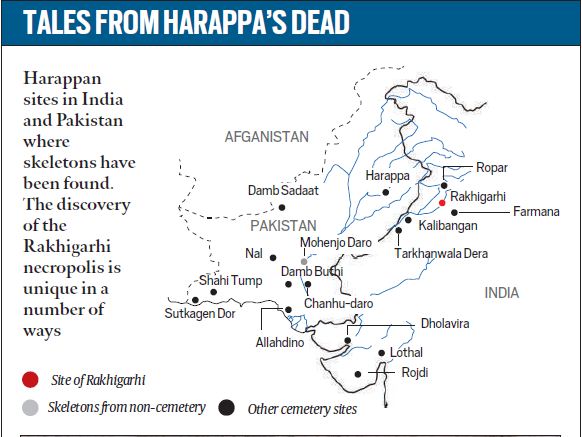Why in news?
A Harappan excavation carried out by Archaeologists in Haryana has unveiled a large burial ground.
What is the brief account of Harappan studies?
- Indus Valley Civilization had been spread across a vast area of land in present day India and Pakistan (around 12 lakh sq.km).
- It is called Harappan civilization after the place (Harappa in Pakistan) where first archaeological evidences for the civilization has been found.
- Harappan studies are focused primarily on urban design, crafts and trade, funeral customs say a lot about a community, what its people value, its social hierarchy, gender relations, and how it treats its children.
- There are five big known centres of the Harappan civilisation of which three are in Pakistan namely Harappa and Ganweriwala in Punjab, and Mohenjo Daro in Sindh).
- The other two important in sites are found in India namely Dholavira and Rakhigarhi.
- Some important burial grounds have been discovered in Lothal (Gujarat), Kalibangan (Rajasthan), Farmana (Haryana), Sanauli (UP).
What is the recent excavation about?
- The excavations has been carried out in place called Rakhigarhi in Haryana by Indian archaeologists, and a South Korean team.
- The necropolis, dated to between 2,500 BC and 2,000 BC, or the Mature Harappan Period, sprawls under a 1 hectare patch of land that has long been under cultivation by present-day residents of Rakhigarhi.

- The excavation yielded graves contained full skeletal remains classified as Primary burials.
- The researchers subcategorised the primary burials into “typical” and “atypical” cases.
- Typical cases - Single bodies buried in supine position inside a plain pit
- Atypical cases - These have brick-lined graves, multiple bodies, or prone-positioned burials.
- In others, only a few human bones were found along with votive pots classified as Secondary burials.
- In yet others, only pots were found, Symbolic burials that suggest that the person died elsewhere.
What are the significant findings on Harappan civilization?
- The Harappan Civilization’s normative form or forms of body disposal remains unclear, since there are possibility of diverse groups following distinctive mortuary customs.
- The recent excavations noted pit burials with multiple bodies, and prone (face down) burials as significant departures from other Harappan necropolises.
- Brick-lined burials (as opposed to plain pits) were among the most elaborately constructed graves, and possibly implied a high social or ritual status.
- The important feature was that every individual found in a brick-lined pit was determined to be female, leading theory that these women played a special role in the community.
- However, women in typical burials got fewer votive pots than men, leading the study that if there were any “discriminatory” attitudes toward women in general.
- In Rakhigarhi, buried individuals seem to have got elaborate burials with numerous grave goods.
- Two burials had been done on a bed of pottery, which may be indicative of high social status.
Source: Indian Express
